Researchers of the Month
September 2025
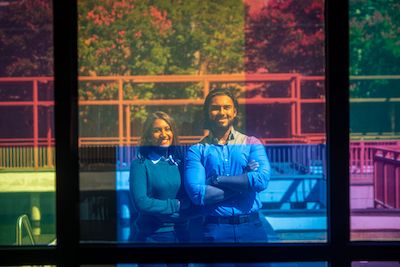 Brandon Jaipersaud
Brandon Jaipersaud
&
Jessinya Jaipersaud
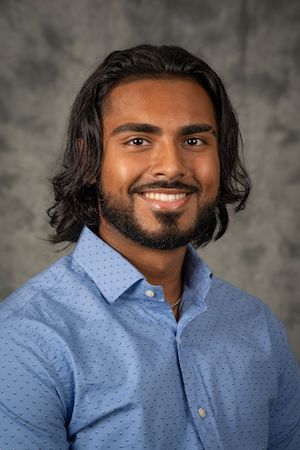
Brandon Jaipersaud
Majors: Computer Science, Applied Math & Statistics; University Scholars honors program
Research Mentor: Dr. David McKinnon, Neurobiology & Behavior
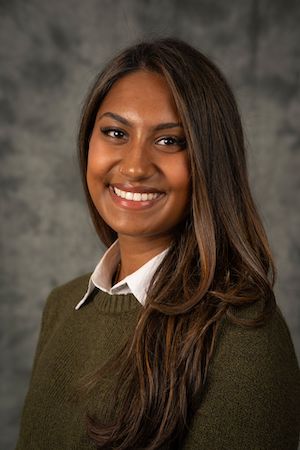
Jessinya Jaipersaud
Major: Technology Systems Management, Specialization in Computer Science
Research Mentor: Amin Shirangi, PhD Candidate, Technology & Society
This month, URECA features two students: Brandon and Jessinya Jaipersaud.
As brother and sister, Brandon and Jessinya have many shared experiences, particularly as both are Stony Brook students, both are interested in AI research, and most recently, both participated in the SUNY SOAR/Summer Opportunity for Academic Research program this past summer. SUNY SOAR, a CIE-URECA collaborative program celebrating its 3rd year, is specifically designed to increase research opportunities for students such as Brandon and Jessinya who are first-generation college and economically disadvantaged students.
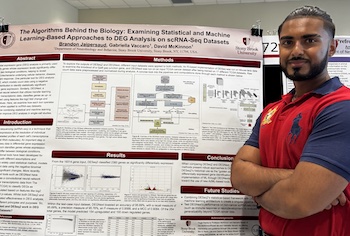 Brandon Jaipersaud is a sophomore majoring in computer science and applied mathematics, and a member
of the University Scholars honors program and Stony Brook’s ColorStack community.
While taking a course on machine learning and data analysis with Dr. David Mckinnon
(Neurobiology and Behavior) in his freshman year, Brandon was drawn towards Bioinformatics
research: as a full-time participant in SOAR ‘25, he had the opportunity to perform
RNA-sequencing on mouse Epithelial Cells to examine the effects of a knockout of the
gap junction gene “Gja8” using an R and Python-based pipeline to input raw gene counts,
remove doublets, filter the samples, and perform scran normalization and UMAP clustering
to examine how the samples changed as a result of the knockout. He utilized the raw,
unfiltered data of these samples to perform Python-based DEG (Differential Gene Expression)
analysis to identify the significantly differentially expressed genes between the
wild type and knockout. At the conclusion of the summer, he presented a poster, “Examining Statistical and Machine Learning-Based Approaches to DEG Analysis on scRNA-Seq
Datasets,” where he described how the RDESeq pipeline works, and also explained his research
into DEG tools, particularly DEGNext, a machine-learning-based model that uses a Convolutional
Neural Network and transfer learning to predict upregulated and downregulated genes
in cancer datasets. Brandon will be presenting at the CommUniversity on September
27 so be sure to stop by and ask him about his research. Brandon’s hobbies include
cooking, listening to music, and fitness; a certified fitness instructor, he plans
to host his own classes at the rec center this fall.
Brandon Jaipersaud is a sophomore majoring in computer science and applied mathematics, and a member
of the University Scholars honors program and Stony Brook’s ColorStack community.
While taking a course on machine learning and data analysis with Dr. David Mckinnon
(Neurobiology and Behavior) in his freshman year, Brandon was drawn towards Bioinformatics
research: as a full-time participant in SOAR ‘25, he had the opportunity to perform
RNA-sequencing on mouse Epithelial Cells to examine the effects of a knockout of the
gap junction gene “Gja8” using an R and Python-based pipeline to input raw gene counts,
remove doublets, filter the samples, and perform scran normalization and UMAP clustering
to examine how the samples changed as a result of the knockout. He utilized the raw,
unfiltered data of these samples to perform Python-based DEG (Differential Gene Expression)
analysis to identify the significantly differentially expressed genes between the
wild type and knockout. At the conclusion of the summer, he presented a poster, “Examining Statistical and Machine Learning-Based Approaches to DEG Analysis on scRNA-Seq
Datasets,” where he described how the RDESeq pipeline works, and also explained his research
into DEG tools, particularly DEGNext, a machine-learning-based model that uses a Convolutional
Neural Network and transfer learning to predict upregulated and downregulated genes
in cancer datasets. Brandon will be presenting at the CommUniversity on September
27 so be sure to stop by and ask him about his research. Brandon’s hobbies include
cooking, listening to music, and fitness; a certified fitness instructor, he plans
to host his own classes at the rec center this fall.
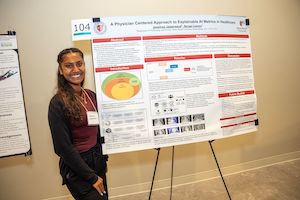 Jessinya Jaipersaud is a senior majoring in Technology Systems Management with a Computer Science Specialization.
Jessinya began working with PhD candidate Amin Shirangi in the Department of Technology
and Society after taking a class, EST 205, and becoming interested in research on
AI and healthcare. Jessinya’s research in the summer SOAR program focused on Explainable
AI (XAI), which addresses the challenge of making artificial intelligence (AI) models,
especially complex models such as deep neural networks (DNNs), more transparent, interpretable,
and trustworthy. She analyzed different explainability metrics and techniques, such
as feature importance analysis, model-agnostic methods (e.g., LIME, SHAP), and visualization
tools (e.g heat maps) that highlight patterns in model decision-making, and explored
how these methods are being applied to healthcare data to help physicians better understand
the reasoning behind AI-generated predictions or diagnoses. Jessinya’s poster at the
Summer Symposium was titled: “Explainable AI - A Physician-Centered Approach to Explainable AI Metrics in Healthcare.” Continuing the project this fall, she plans to conduct a behavioral analysis of radiologists
from various hospitals, including Stony Brook Hospital, Mount Sinai, and others, to
better understand how AI tools impact physicians’ trust, autonomy, and clinical decision-making,
as well as their perspectives on integrating these tools into their workflows. Jessinya is a part of Girls Who Code and the ColorStack community. Aside from academics,
her hobbies include weightlifting and baking so much so that she started her own small
business, Sugar Crumbs Co. She intends to pursue employment as a Technical Project
or Product Manager or Business Analyst following her graduation, and is passionate
about the intersection of technology and business. Jessinya will be presenting at
the AI in Healthcare Conference at Rice University in September with URECA support.
Jessinya Jaipersaud is a senior majoring in Technology Systems Management with a Computer Science Specialization.
Jessinya began working with PhD candidate Amin Shirangi in the Department of Technology
and Society after taking a class, EST 205, and becoming interested in research on
AI and healthcare. Jessinya’s research in the summer SOAR program focused on Explainable
AI (XAI), which addresses the challenge of making artificial intelligence (AI) models,
especially complex models such as deep neural networks (DNNs), more transparent, interpretable,
and trustworthy. She analyzed different explainability metrics and techniques, such
as feature importance analysis, model-agnostic methods (e.g., LIME, SHAP), and visualization
tools (e.g heat maps) that highlight patterns in model decision-making, and explored
how these methods are being applied to healthcare data to help physicians better understand
the reasoning behind AI-generated predictions or diagnoses. Jessinya’s poster at the
Summer Symposium was titled: “Explainable AI - A Physician-Centered Approach to Explainable AI Metrics in Healthcare.” Continuing the project this fall, she plans to conduct a behavioral analysis of radiologists
from various hospitals, including Stony Brook Hospital, Mount Sinai, and others, to
better understand how AI tools impact physicians’ trust, autonomy, and clinical decision-making,
as well as their perspectives on integrating these tools into their workflows. Jessinya is a part of Girls Who Code and the ColorStack community. Aside from academics,
her hobbies include weightlifting and baking so much so that she started her own small
business, Sugar Crumbs Co. She intends to pursue employment as a Technical Project
or Product Manager or Business Analyst following her graduation, and is passionate
about the intersection of technology and business. Jessinya will be presenting at
the AI in Healthcare Conference at Rice University in September with URECA support.
Both Brandon and Jessinya found the SOAR program to be transformative in building their confidence, increasing their connection to the community and campus networks, and building communication skills. Brandon valued the program because it enabled him to “focus on research in a new field without having any external pressures to worry about.” Jessinya notes that the “community-building element” was such a valuable part of the experience: “My biggest piece of advice is to go beyond simply networking, truly connect with those around you. Have genuine conversations, share not just your research but also who you are as a person, and let your unique experiences and background shine. Put yourself out there, embrace the community, and lean into the relationships you build.”
Brandon is a graduate of the Queens High School for the Sciences at York College (QHSS). Jessinya is a graduate of Queens Gateway to Health Sciences Secondary School. Below are excerpts of Brandon & Jessinya’s interview with Karen Kernan, URECA Director.
The Interview:
Karen: Let’s start by telling me what research group you're in, and how you first got involved in research.
Jessinya: I'm a member of Amin Shirangi's research group in the Department of Technology and Society. I originally got acquainted with my mentor when I first took his EST 205 course, which focused on technological design. At the start of the semester, my professor mentioned that he was conducting research, and it immediately sparked my interest since I had been looking for a way to venture into this field. Once the semester was over, I emailed him, and we set up a meeting where he explained his current project and how I could be a part of this journey. I was very interested, especially in the intersections of Artificial Intelligence (AI) and healthcare, and so, my initial research began! Fast forward to the spring, I applied and was accepted into the SUNY SOAR summer program. Over the course of the program, I focused on explainable AI within the broader context of AI in healthcare. And now, returning in the fall semester, I will be continuing on the project along with another undergraduate researcher, where we plan to expand the work to a behavioral analysis of how physicians feel about integrating AI tools into their clinical workflows and how the integration of AI tools affects their autonomy, trust, and clinical decision-making.
Brandon: I actually met my PI during the fall semester of my freshman year. As part of university scholars, I was given the opportunity to take a one-credit course in machine learning and its applications to computational biology with Dr. David McKinnon. I was very interested in joining Dr. McKinnon’s lab for research, and he was actually the individual who introduced me to the SOAR summer research program in the first place. After joining his journal club in my second semester, Professor McKinnon encouraged me and my peers to apply, saying that he would be willing to write us letters of recommendation. So that was actually how I found out about and applied to the SOAR program in the first place. As a CS and AMS major, I was very interested in applying my CS-based knowledge in fields other than just tech, and so, over the course of the summer, I focused on the field of bioinformatics, analyzing data using R and Python-based pipelines and using clustering models and visualization tools like UMAP and BioVenn to visualize. Collectively, breaking into CS research via an interdisciplinary field was something that I saw as a great opportunity through his lab.
How beneficial was it to have the opportunity to dedicate yourself to research full time through the SOAR program?
Jessinya: I found the SOAR program incredibly valuable because it provided a generous grace period to truly focus and invest in a research project from start to finish. It’s incredibly rewarding to see a project come to fruition, evolving from the ideation stage to completion. Having the time, space, and energy to fully dedicate myself allowed me to put my best foot forward on the project. The SOAR program did an amazing job of removing common stressors, such as dorming or living expenses, giving me a clear pathway to focus all of my attention on my research. The program truly provided adequate resources, support, and mentorship to help me be my best self throughout this process.
Brandon: I totally agree with my sister. I feel like all the amenities provided by the SOAR program made the transition almost seamless, as we were pretty much able to just hone in on our research. Since it was my first time doing research, there was a pretty steep learning curve in my field. As a result, getting used to the idea of ambiguity, being really comfortable with making mistakes, and experiencing countless trials and errors, all without the added stress of worrying about dorm costs or even worrying about classes, was invaluable. I feel like the SOAR program excelled in that sense, since it really allowed us to make our mistakes and focus on research without having any external things to worry about.
What did you most enjoy about the SOAR program?
Jessinya: Personally, the workshops we had on Mondays and Wednesdays, and the element of community-building embedded in all the workshops/events, were very enjoyable. As Brandon mentioned, this is especially true when you’re doing something for the first time, as these workshops help you navigate the ambiguous aspects of research. For example, thinking back to the poster presentation workshops with Dr. Samantha Cobos, having a professional guide us on how to create a poster and communicate our ideas to non-technical audiences was extremely valuable. I definitely plan to apply this knowledge as I prepare for my upcoming research presentation at Rice University. Also, workshops on creating an IDP (Individual Development Plan) and exploring fellowship opportunities such as the GEM Fellowship were extremely helpful as well, as they provided resources for setting clear career goals and identifying growth opportunities I wouldn’t have known about otherwise. There are so many resources available, and these workshops did an amazing job connecting us with them while highlighting new opportunities. And so, learning about these resources and connecting with staff members in the CIE group, such as Lisa, Diana, and Grace, and my fellow peers was incredibly enjoyable, as well.
Brandon: I agree. The workshops focused not only on teaching us the technical skills, but also on how to develop our oral presentation skills, which is something I felt was very important. I really enjoyed the “how to present your poster,” especially since it taught us to take into account the fact that we will not always be talking to audiences who are experts in the fields we are doing research in. Being able to differentiate when and how we should present our information is a very important part of research in general, and practicing our presentations helped me to develop skills that I will personally keep with me for the rest of my academic journey if I do decide to pursue research or academia further. On the social aspect, I believe one of my favorite events was the Sunset Social at the beach! Because it was towards the beginning of the program itself, it allowed a lot of our peers to come together and really understand each other as people.
Was this for both of you the first time that you were presenting a research poster?
Jessinya: Yes, this was my very first time presenting a poster, and having the background from the workshops really helped me feel confident and prepared for the symposium. Reflecting back on the experience, it was incredibly rewarding to see how much I learned about my field, and to have the opportunity to share that knowledge with others. During the symposium, seeing people take an interest in my work and in the healthcare field more broadly was especially meaningful, since healthcare affects everyone in some way. I noticed that when I first started presenting, I had to remind myself to read my audience, which helped me become more natural in the way that I was presenting my project and conveying my ideas. Beyond presenting, I really enjoyed walking around and hearing other people’s work as well. It was such an amazing experience because, even though our projects were all so different, we came together to share diverse and unique perspectives on various topics. Being able to see what others are doing and learn from their unique approaches made the symposium even more rewarding and memorable. Even though this was my first experience, I feel it serves as a stepping stone for many more opportunities to present my research and my work to different audiences in the future.
Brandon: This was also my very first time presenting a poster, and yes, the symposium was quite an experience! I have to say I did feel a bit nervous at the start of the program, largely since this was my first formal research experience. However, as I grew more and more familiar with my research and practiced my presentation skills through the workshops, I grew confident in presenting. Being able to share these experiences with my peers made the experience worthwhile, as well. I would even say that my favorite part of the symposium was learning about the diverse areas of research our peers were participating in, as well as witnessing how they were able to present their own research and findings in such an eloquent way. I also enjoyed walking around the symposium and gaining insights into what other labs were working on, which contributed greatly to the memorable experience it was. It was really amazing to see how everyone was able to hone in and really master the skill of presenting, too!
If you were giving advice to other students about applying for summer programs, what advice would you give them? Do you have any tips as to how to make the most of the experience?
Jessinya: My biggest piece of advice would be to put yourself out there and really connect with the community. Sometimes people get so caught up in their own worlds that they lose the human element. So lean into your community, whether that’s the CIE or your research lab. For me, talking to people outside of my field was incredibly valuable, because you never know what might come from a simple conversation. I had great discussions with Lisa, Diana, and Grace from CIE, as well as my fellow peers from the SOAR program. My biggest piece of advice is not just to network, but to connect on a deeper level by having conversations, sharing who you are, and talking to people not only about your research but also about yourself and who you are as a person. Let your diversity and individuality shine, because it’s truly rewarding to see people from different walks of life, learn about what they’re doing, and communicate with them. And so, be active in your community, lean into it, and embrace every opportunity to connect with those around you.
Brandon: From my perspective, the one piece of advice I would give is to embrace every opportunity that comes your way and become comfortable with the unknown. It can feel a little scary when you are first doing something completely new and are unsure of how to tackle things that you don’t quite fully understand. For me, I was venturing into a field that was somewhat new to me content-wise, as it required a pretty deep knowledge of cellular biology to actually interpret the literature I was reading and the results I was getting. So, learning to be comfortable with obscurity was a big part of the process. I had to become well-versed in learning to do my own research behind the scenes, to kind of get a greater understanding of what was going on and what I was doing. So even while individuals may shy away from opportunities because of a feeling of unpreparedness, being willing to put in the extra work to understand things on your own time is absolutely crucial. For certain, you will always be learning, and so you have to be prepared to learn on the job, so to speak--that’s pivotal in making sure that you make the most out of any opportunity in research.
How have your mentors helped you with this research experience?
Brandon: Dr. McKinnon was an amazing mentor. In fact, over the course of the summer, we participated in weekly journal clubs on top of our research, so even while we were doing our own research, we were still learning a lot about machine learning and neural networks. As a PI, he was very approachable and welcoming and was always more than willing to help out in bridging gaps in knowledge, especially considering his expertise as a biologist. At first, I found myself being overly independent in trying to figure out the solutions to problems, when in reality, mentors are there for a reason. And as a result, I learned how to be okay with asking questions, and how to be comfortable with diving into fields that at first I didn’t know much about because of Dr. McKinnon.
Jessinya: My mentor, Amin Shirangi, was also very approachable and very welcoming to any ideas that my research partner and I had. Throughout the course of this project, there were many times where I caught myself going down a rabbit hole. I’m a very curious person, so I often found myself diving too deeply into certain concepts and occasionally straying beyond the scope of the project. And so, he helped me stay on track, clarify the scope, and navigate the project step by step. He was always willing to bridge the gaps in my understanding weather by either breaking down difficult technical concepts or helping me interpret complex results. He truly guided me in thinking critically about my work while also making sure I didn’t lose sight of the bigger picture. I had many questions, but he always took the time to answer them, and was approachable, open to different ideas, and made sure I felt comfortable and confident in what I was doing. Professor Shirangi was welcoming, available, and very present in our conversations, as well. I feel that every time I had a concern, he addressed it head on and with openness to anything I had to say. He is truly an amazing mentor, professor, and individual.
I’m so glad you both had the opportunity to participate in SOAR.
Jessinya: When we first received our acceptance letters and realized we had both been accepted into the SOAR program, it felt like a breath of fresh air knowing we would be navigating this journey together. I’m so glad we were able to share this experience. We are truly grateful for the program and for the opportunities, resources, and community it provided us. As first-generation college students, even talking to our parents about research is something unfamiliar to them, so having this kind of support was especially meaningful. I believe the program has tremendous potential to change students’ lives and open doors for them to venture into new spaces and areas they may have never imagined. Thank you so much Karen for taking the time to speak with us today!
Brandon: I second that. I really am grateful to Dr. McKinnon and the SOAR program for providing me with such a great experience! It was such an amazing opportunity to work on research, and also be a part of an intimate community with peers that I will surely keep in contact with in the future. I also agree with the point that the program holds so much potential, but even at the point that it is currently in, it holds the power to truly make a difference in students’ academic experience. Thanks so much for having us today for this interview!
